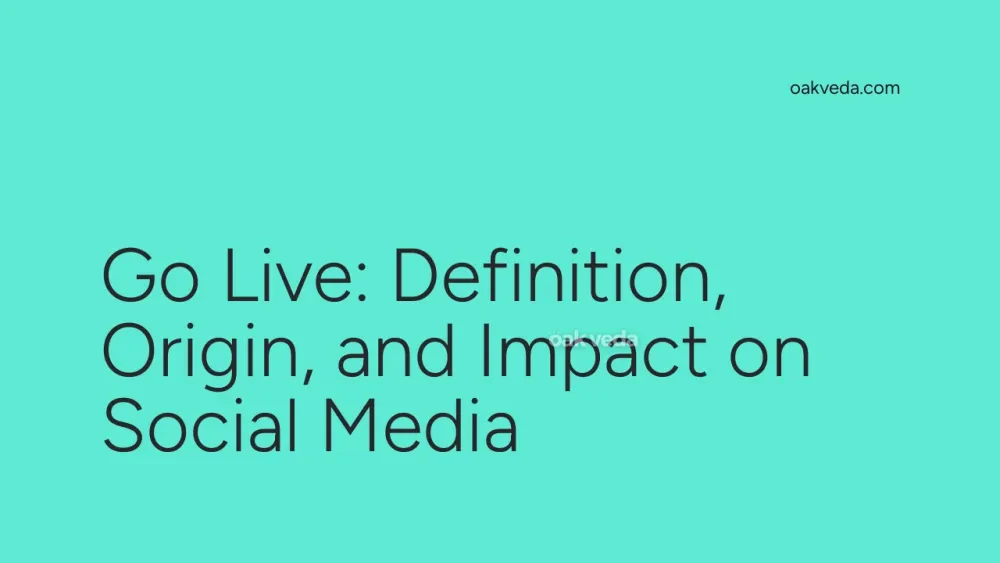
What is Go Live?
"Go Live" is a popular feature on social media platforms that allows users to broadcast real-time video content to their followers or a wider audience. This interactive tool enables individuals, brands, and influencers to share experiences, thoughts, or events instantaneously, creating a sense of immediacy and connection with viewers.
Origin and Development of Go Live
The concept of live streaming has been around since the early days of the internet, but it gained significant traction on social media platforms in the mid-2010s. Facebook introduced its Live feature in 2015, initially for celebrities and public figures, before rolling it out to all users in 2016. Other platforms quickly followed suit, with Instagram, YouTube, and Twitter (now X) launching their own live streaming capabilities.
How Go Live Works
When a user decides to go live, they activate the live video feature on their chosen social media platform. This initiates a real-time video stream from their device's camera or connected equipment. The platform then notifies the user's followers or a selected audience about the live broadcast. Viewers can join the stream, leave comments, ask questions, and react to the content in real-time.
Popular Platforms for Going Live
- Facebook Live: Offers extensive reach and the ability to save live videos for later viewing.
- Instagram Live: Integrated with Stories, allowing for spontaneous and ephemeral broadcasts.
- YouTube Live: Ideal for longer-form content and monetization opportunities.
- TikTok LIVE: Caters to short-form, engaging content with unique interactive features.
- Twitch: Primarily used for gaming content but expanding to other categories.
Impact of Go Live on Social Media Culture
Going live has significantly transformed social media culture in several ways:
- Authenticity: Live streams offer unfiltered, raw content, fostering a sense of authenticity and trust.
- Immediate engagement: Real-time interaction creates a stronger connection between content creators and their audience.
- FOMO (Fear of Missing Out): The ephemeral nature of live content encourages users to tune in immediately.
- Democratization of content: Anyone with a smartphone can become a broadcaster, leveling the playing field for content creation.
How Brands and Influencers Use Go Live
Brands and influencers have embraced the go-live feature as a powerful marketing and engagement tool:
- Product launches: Unveiling new products or services in real-time to generate excitement.
- Q&A sessions: Hosting live question-and-answer sessions to interact directly with customers or followers.
- Behind-the-scenes content: Offering exclusive glimpses into production processes or daily operations.
- Live events: Broadcasting conferences, concerts, or other events to a global audience.
- Tutorials and demonstrations: Showcasing products or skills in real-time, allowing for immediate feedback and questions.
Future Trends Related to Go Live
As technology evolves, we can expect several trends to shape the future of live streaming on social media:
- AI-powered enhancements: Artificial intelligence may be used to improve video quality, moderate comments, and provide real-time translations.
- Virtual and augmented reality integration: Immersive experiences that blend the physical and digital worlds during live streams.
- Increased monetization options: More platforms may introduce tipping, subscriptions, or revenue-sharing models for live content creators.
- Multi-platform streaming: Tools that allow simultaneous broadcasting across multiple social media platforms.
- Interactive shopping experiences: Live shopping events where viewers can purchase products directly through the stream.
Controversies and Challenges Surrounding Go Live
While going live offers numerous benefits, it also presents some challenges:
- Content moderation: The real-time nature of live streams makes it difficult to monitor and control inappropriate content.
- Copyright infringement: Live streaming of copyrighted material, such as sports events or concerts, can lead to legal issues.
- Privacy concerns: Accidental sharing of sensitive information or unintended background content during live streams.
- Technical difficulties: Internet connectivity issues or equipment failures can disrupt live broadcasts.
FAQs about Go Live
-
How long can I go live on social media platforms? Duration limits vary by platform. For example, Facebook allows up to 8 hours, while Instagram caps at 4 hours.
-
Do I need special equipment to go live? While a smartphone is sufficient for most live streams, some creators use external microphones, lighting, or cameras for higher quality broadcasts.
-
Can I save my live stream for later viewing? Many platforms offer the option to save live videos and share them as regular posts after the broadcast ends.
-
How can I grow my audience for live streams? Consistently schedule your live sessions, promote them in advance, and engage with your viewers to build a loyal following.
-
Are there age restrictions for going live? Most platforms require users to be at least 13 years old, with some features restricted to users 18 and older.
Going live has revolutionized the way we interact on social media, offering unprecedented opportunities for real-time engagement. As technology continues to advance, we can expect this feature to evolve, providing even more immersive and interactive experiences for users worldwide. Whether you're a brand looking to connect with customers or an individual sharing your passion, mastering the art of going live can significantly enhance your social media presence and impact.
You may be interested in:
- ICYMI: Definition, Origin, and Impact on Social Media
- BeReal: Definition, Origin, and Impact on Social Media
- Evergreen Content: Definition, Origin, and Impact
- Brand Partnership: Definition, Origin, and Impact
- Social Media Management: Definition, Origin, and Impact
- Lookalike Audience: Definition, Origin, and Impact

